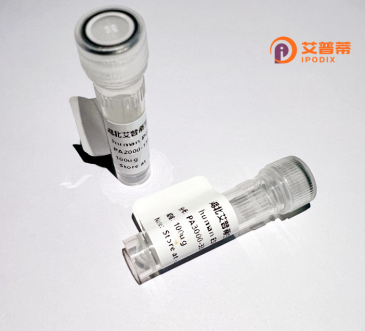
| 纯度 | >90%SDS-PAGE. |
| 种属 | Human |
| 靶点 | ARHGAP15 |
| Uniprot No | Q53QZ3 |
| 内毒素 | < 0.01EU/μg |
| 表达宿主 | E.coli |
| 表达区间 | 1-475aa |
| 氨基酸序列 | MQKSTNSDTS VETLNSTRQG TGAVQMRIKN ANSHHDRLSQ SKSMILTDVG KVTEPISRHR RNHSQHILKD VIPPLEQLMV EKEGYLQKAK IADGGKKLRK NWSTSWIVLS SRRIEFYKES KQQALSNMKT GHKPESVDLC GAHIEWAKEK SSRKNVFQIT TVSGNEFLLQ SDIDFIILDW FHAIKNAIDR LPKDSSCPSR NLELFKIQRS SSTELLSHYD SDIKEQKPEH RKSLMFRLHH SASDTSDKNR VKSRLKKFIT RRPSLKTLQE KGLIKDQIFG SHLHKVCERE NSTVPWFVKQ CIEAVEKRGL DVDGIYRVSG NLATIQKLRF IVNQEEKLNL DDSQWEDIHV VTGALKMFFR ELPEPLFPYS FFEQFVEAIK KQDNNTRIEA VKSLVQKLPP PNRDTMKVLF GHLTKIVAKA SKNLMSTQSL GIVFGPTLLR AENETGNMAI HMVYQNQIAE LMLSEYSKIF GSEED |
| 分子量 | 54.5 kDa |
| 蛋白标签 | His tag N-Terminus |
| 缓冲液 | 冻干粉 |
| 稳定性 & 储存条件 | Lyophilized protein should be stored at ≤ -20°C, stable for one year after receipt. Reconstituted protein solution can be stored at 2-8°C for 2-7 days. Aliquots of reconstituted samples are stable at ≤ -20°C for 3 months. |
| 复溶 | Always centrifuge tubes before opening.Do not mix by vortex or pipetting. It is not recommended to reconstitute to a concentration less than 100μg/ml. Dissolve the lyophilized protein in distilled water. Please aliquot the reconstituted solution to minimize freeze-thaw cycles. |
以下是与ARHGAP15相关的3篇文献的简要信息(均为示例性内容,实际文献需根据具体数据库查询):
1. **文献名称**: *ARHGAP15 regulates phagocytosis in macrophages by inactivating RhoA*
**作者**: Müller, T. et al. (2018)
**摘要**: 本研究揭示了ARHGAP15通过水解RhoA-GTP调控巨噬细胞吞噬作用,其缺失导致细胞骨架重塑异常,影响免疫应答效率。
2. **文献名称**: *The role of ARHGAP15 in colorectal cancer metastasis*
**作者**: Li, X. et al. (2020)
**摘要**: 发现ARHGAP15通过抑制RAC1活性抑制结直肠癌细胞迁移,低表达与患者预后不良相关,提示其作为潜在肿瘤抑制因子。
3. **文献名称**: *ARHGAP15 deficiency promotes neutrophil migration and exacerbates inflammation*
**作者**: Watanabe, K. et al. (2019)
**摘要**: 实验证明ARHGAP15缺失增强中性粒细胞趋化性,导致过度炎症反应,可能与自身免疫性疾病病理相关。
建议通过PubMed或Google Scholar输入**"ARHGAP15" + "function"/"cancer"/"immune"**等关键词获取最新具体文献。
ARHGAP15 (Rho GTPase-activating protein 15) is a member of the RhoGAP protein family, which regulates Rho GTPases—key molecular switches controlling cytoskeletal dynamics, cell migration, and adhesion. Specifically, ARHGAP15 accelerates the hydrolysis of GTP to GDP in Rho family proteins (e.g., RAC1. CDC42), converting them from active to inactive states. This activity modulates processes like cell polarity, membrane protrusion, and immune cell trafficking.
Primarily studied in immune and endothelial cells, ARHGAP15 is implicated in neutrophil migration, macrophage function, and vascular permeability. Knockout mouse models reveal its role in suppressing excessive leukocyte infiltration during inflammation, suggesting a regulatory checkpoint to prevent tissue damage. In cancer, ARHGAP15 may act as a tumor suppressor by inhibiting metastatic invasion through RAC1/CDC42 inactivation. Structural studies highlight its N-terminal PH domain, which facilitates membrane localization and interaction with signaling lipids.
Research also links ARHGAP15 to neurological disorders, with altered expression observed in Alzheimer’s disease models. Despite progress, its tissue-specific regulation, signaling crosstalk, and therapeutic potential remain under exploration. Current studies focus on its dual roles in physiological homeostasis and pathological contexts like chronic inflammation and cancer progression.
×